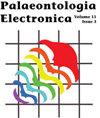Distinguishing between three modern Ellobius species (Rodentia, Mammalia) and identification of fossil Ellobius from Kaldar Cave (Iran) using geometric morphometric analyses of the first lower molar
IF 2
4区 地球科学
Q1 Earth and Planetary Sciences
引用次数: 7
Abstract
Ellobius remains are common and often abundant in southeastern Europe, western and central Asia archaeological sites. A correct identification of species is crucial for our understanding of the evolution of species and communities through time, including biostratigraphic sequences to be established. This study applies geometric morphometric methods (GMM) to Ellobius first lower molars, with the objectives: 1) to discriminate modern species and explore morphological and size differences in reference samples; and 2) to identify fossil specimens recovered in archaeological sites, based on the aforementioned analysis. The reference dataset used in this paper includes specimens belonging to the three species that today occur in the southeastern Europe, western and central Asia: Ellobius fuscocapillus, E. lutescens and E. talpinus. The archaeological material comes from Late Pleistocene Iranian site of Kaldar Cave (Khorramabad valley, Lorestan Province, western Iran). Our study shows that the shape of the anterior cap and the arrangement of the following triangles allow discriminating the three studied extant Ellobius species. The shapes of E. fuscocapillus and E. lutescens m1 appear rather similar, whereas Ellobius talpinus is well separated from these two species. The total length and the anterior cap of m1 in E. fuscocapillus is greater than in Ellobius lutescens. The GMM analyses performed on the modern reference dataset allowed us to identify fossil specimens from Kaldar Cave as E. lutescens and some as E. fuscocapillus, and excluding E. talpinus.用第一下磨牙的几何形态分析鉴定伊朗卡尔达尔洞穴的三种现代懒虫(啮齿目和哺乳类)
埃洛比乌斯遗迹在欧洲东南部、西亚和中亚的考古遗址中很常见,而且经常很丰富。正确识别物种对于我们理解物种和群落随时间的演变至关重要,包括即将建立的生物地层学序列。本研究将几何形态计量方法(GMM)应用于Ellobius第一下磨牙,目的是:1)区分现代物种,探索参考样本的形态和大小差异;以及2)基于上述分析来鉴定在考古遗址中发现的化石标本。本文中使用的参考数据集包括属于今天出现在东南欧、西亚和中亚的三个物种的标本:褐叶兰、木犀和talpinus。考古材料来自伊朗晚更新世Kaldar洞穴遗址(伊朗西部洛雷斯坦省Khorramabad山谷)。我们的研究表明,前帽的形状和以下三角形的排列可以区分三种已研究的现存埃洛比乌斯物种。褐藻E.fuscocapillus和木犀E.lutescens m1的形状看起来相当相似,而talpinus Ellobius与这两个物种很好地分离。梭毛E.fuscocapillus中m1的总长度和前帽大于木犀。在现代参考数据集上进行的GMM分析使我们能够将Kaldar洞穴的化石标本鉴定为E.lutescens,一些鉴定为E.fuscocapillus,不包括E.talpinus。
本文章由计算机程序翻译,如有差异,请以英文原文为准。
求助全文
约1分钟内获得全文
求助全文
来源期刊

Palaeontologia Electronica
地学-古生物学
CiteScore
3.60
自引率
0.00%
发文量
20
审稿时长
>12 weeks
期刊介绍:
Founded in 1997, Palaeontologia Electronica (PE) is the longest running open-access, peer-reviewed electronic journal and covers all aspects of palaeontology. PE uses an external double-blind peer review system for all manuscripts. Copyright of scientific papers is held by one of the three sponsoring professional societies at the author''s choice. Reviews, commentaries, and other material is placed in the public domain. PE papers comply with regulations for taxonomic nomenclature established in the International Code of Zoological Nomenclature and the International Code of Nomenclature for Algae, Fungi, and Plants.
 求助内容:
求助内容: 应助结果提醒方式:
应助结果提醒方式:


